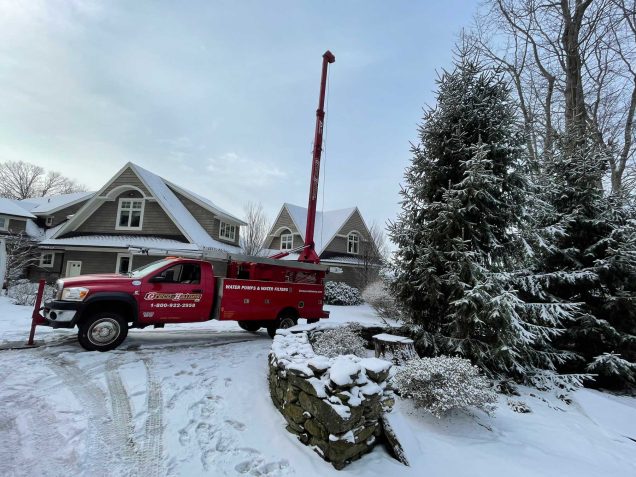Low water pressure can be a problem any time of year for owners of a private well. However, wintertime brings a few tricky circumstances that may enhance the likelihood you’ll face this issue.
Low water pressure is extremely annoying, but it can also indicate a pressing issue to be addressed within your plumbing system. In this article, we’ll run through some tips for identifying the underlying problem of low water pressure and coming up with an effective solution.
Whether it’s low water pressure or anything else to do with your well system this winter, don’t hesitate to contact the Greco & Haines team! We’re here to help seven days a week and 365 days a year.
Now, let’s dig into the details: six ways to respond to low water pressure in your home.
1. Check for Frozen Pipes
What is the nightmare for many homeowners during winter cold streaks? Frozen pipes. Pipes in unheated parts of your home that aren’t insulated are subject to freezing. You must be especially careful if your furnace dies or there’s an extended power outage that robs you of your primary source of household heat. This is when your water lines are most susceptible to freeze.
Ice forming in one or more of your pipes can certainly restrict water flow or even cut it off entirely. In the worst-case scenario – given water expands when it freezes into ice – it could strain your pipes and rupture them.
So, if you’re suddenly facing reduced output from your taps during the winter, you should keep the possibility of a frozen pipe somewhere in mind. Check out this Greco & Haines post on dealing with frozen pipes for more information.
2. Check for Leaks
Whether it’s caused by ice buildup or another reason, a leaking pipe anywhere in your system could result in diminished water pressure. Identifying a small leak or a leak in a hard-to-access plumbing section can definitely be a challenge. Don’t forget to check the pressure tank and other fixtures as well as pipes.
Minor leaks may be able to be temporarily patched up. But if you suspect one, it’s a good idea to have a plumber evaluate your system to hone in on the location, identify the cause, and offer a long-term solution. A pipe leaking because of age or corrosion can signal additional leaks to come in other areas of your home.
3. Check the Pressure Switch
This is often overlooked, but improving water pressure may be as simple as adjusting the pressure switch associated with your pressure tank. Generally, your household water pressure should be somewhere between 40 and 60 PSI.
4. Check for Clogged Pipes or Fixtures
Ice, of course, isn’t the only thing that can restrict water flow through your pipes. Mineral or sediment buildup is another frequent culprit. A good water softener can often mitigate this sort of issue.
Check if the water pressure is low in all the taps throughout your home. If not, you may be able to narrow down the issue to a clogged aerator or showerhead. You can clean or replace these as necessary to fix the problem.
5. Check Plumbing Valves
Damaged or malfunctioning valves may also be to blame for your low-water-pressure woes. That might include a main shut-off valve that doesn’t fully open or a broken pressure-reducing valve. Inspect your water heater if the low pressure is only associated with hot water. A failing shut-off valve on the water heater, for example, could be the cause for the low pressure.
6. Install a Constant Pressure System
Many low-water-pressure issues are simply temporary fluctuations due to competing simultaneous demand. For example, when the shower is running at the same time as the washing machine, it’s normal to experience low pressure. However, a constant pressure system, driven by a submersible pump whose motor speed is adjusted based on demand, could be your solution. Get in touch with the Greco & Haines team to learn more about this technology.
Other solutions might include upgrading your well pump, installing a booster pump, or adding another pressure tank to your system.
Greco & Haines: Water Pressure, Well Water Services, and Water Quality Testing in CT
Sometimes increasing your water pressure is as simple as adjusting the pressure valve or cleaning a faucet’s aerator. Other times it’s a somewhat more complicated matter of tracking down an insidious leak, evaluating the mineral content of your well water, replacing worn calves, or diagnosing some specific problem in a component. Keep in mind that low water pressure can also reflect declining volume in the aquifer that your well taps into.Whatever problems you face regarding your well water, the expert team here at Greco & Haines can help you. Greco & Haines is the best well water company in Connecticut to solve your problems, from water pressure to well installation and water quality testing to water pump removal. We offer service seven days a week and 365 days a year. For more information about our well water services in CT, contact us today via our online contact form. Call any time at 203-735-9308 or 203-777-2256 or call toll-free from any CT area code 1-800-922-2958

